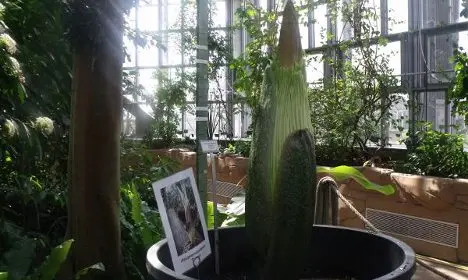Botany experts are excited to witness the rare opening of the Titan arum, a tropical plant that gives off a powerful pungent stench.
Though she can’t predict for certain when the flower will unfurl and begin to stink up the grounds, botanical gardens spokeswoman Gesche Hohlstein told The Local this week that the event was imminent.
“The earliest that we would know on any given day would be around midday,” she said.
The staff are now on tenterhooks while waiting for the opening of the plant’s inflorescence and its accompanying disgusting stench. The flower remains open for just a few days with the stench the most potent at the beginning.
“It gives off a real stink,” said Hohlstein. “Like a mix of rotting flesh, urine, and faecal matter.”
Click here for a photo gallery of the giant stinky flower
The Titan arum, also known as the “corpse flower” due to its unique aroma, originally comes from Sumatra, Indonesia. Its putrid smell and deep red colour are designed to attract flies and other insects by fooling them into thinking that it is rotter cadaver. The insects help with the pollination process.
“The specimen we have here is extremely unusual, because it’s displaying its inflorescence after only two years instead of after the normal pause of three years,” Hohlstein explained.
The bulb of the Titan arum can weigh in at over 100 kilogrammes, with its inflorescence the single largest of any plant in the world. The spathe, or the central part of the plant, is currently growing at a visible speed ahead of the opening.
“On Monday it had reached 95 centimetres, with a further 10 centimetres growth visible on Tuesday,” said Hohlstein.
A measuring stick has been placed next to the plant so that researchers can record just how fast it’s rising, and the staff are working on setting up a webcam to broadcast the natural spectacle live.
Once the flower has blossomed and emitted its unique stench, it will remain open for around three days. The inflorescence contracts around the spathe, which eventually collapses. The visible part of the plant then dies, although the bulb, or corm, begins a process of energy storing and renewal.
Staff at the botanical gardens are anticipating a flood of visitors, from plant enthusiasts to curious children, all excited to experience such a rare phenomenon.
“This moment is absolutely an event for us here at the gardens,” said Hohlstein.
Ruth Michaelson (news@thelocal.de)

Comments